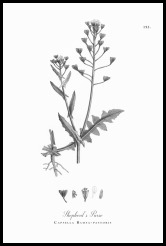 These authors conducted a triple-blind, randomized, placebo-controlled clinical trial to evaluate the effects of Shepherd’s purse hydroalcoholic extract on heavy menstrual bleeding for two consecutive menstrual cycles.
These authors conducted a triple-blind, randomized, placebo-controlled clinical trial to evaluate the effects of Shepherd’s purse hydroalcoholic extract on heavy menstrual bleeding for two consecutive menstrual cycles.
This study was a triple-blind, randomized, placebo-controlled clinical trial to evaluate the effects of Shepherd’s purse extract on heavy menstrual bleeding. At medical clinics affiliated with the University of Medical Sciences in Tehran, Iran, women were included if they had a regular menses, heavy menstrual bleeding (based on a pictorial blood loss assessment chart= PBLAC > 100), were ages 18-45 of normal weight or overweight but not obese, confirmed to not be pregnant and no known gynecological disease and a normal pelvic ultrasound.
If their score was > 100, indicating heavy menstrual bleeding, they were enrolled and randomly assigned to each group. There were 50 in the Shepherd’s purse group and 50 in the placebo group. Women in the Shepherd’s purse group were given an extract with 96% ethanol and dried extract; each capsule containing 320 mg of shepherd’s purse hydroalcoholic extract along with a starch powder. Participants took either two capsules of Shepherd’s purse every 12 hours from day one of menses to the end of the menstrual period plus mefenamic acid two 500 mg capsules every 8 hours from day one until end of menses or placebo plus mefenamic acid.
Eight women in the Shepherd’s purse group were excluded due to irregular use of the medications or inaccurate forms or stomach irritation. Eight women in the placebo group were excluded due to irregular use of medications or stomach irritation. In the end, the study evaluated 42 women from each group.
While there was a significant reduction in the amount of menstrual bleeding was seen in both groups, there was no significant difference between the groups the first and second month; however, at the end of the third month, the treatment group had a significantly greater reduction in the mean PBLAC score compared to the placebo group. The average number of bleeding days was also significantly reduced in both groups although at the end of the third month it did not significantly differ between the groups; however, the reduction in the volume of blood loss was rate was significantly higher in the Shepherd’s purse group and the women were more satisfied with the results in the Shepherd’s purse group.
Commentary:
This is good news for Shepherd’s purse extract and heavy menstrual bleeding, with the best results happening in the third month. Mefenamic acid is used not only for menstrual cramps, but this same anti-inflammatory effect can reduce heavy menstrual bleeding as well, which is why it was added to the treatment and placebo groups in this study. Readers might also want to look back at the March 2018 blog and a report on Shepherd’s purse in postpartum bleeding.
Shepherd’s purse has long been an important herb that I have used for heavy menstrual bleeding, postpartum hemorrhage and intermenstrual bleeding due to its hemostatic and anti-inflammatory properties. But this use has been based on historical and traditional uses rather than studies on women with this problem. So this study has special interest and clinical relevance to me and my clinical practice.
Reference: Naafe M, Kariman N, Keshavarz Z, Khademi N, Mojab F, Mohammadbeigi A. The effect of hydroalcoholic extracts of Capsella bursa-pastoris on heavy menstrual bleeding: a randomized clinical trial. J Altern Complement Med. July 2018;24(7):694-700. doi: 10.1089/acm.2017.0267.

